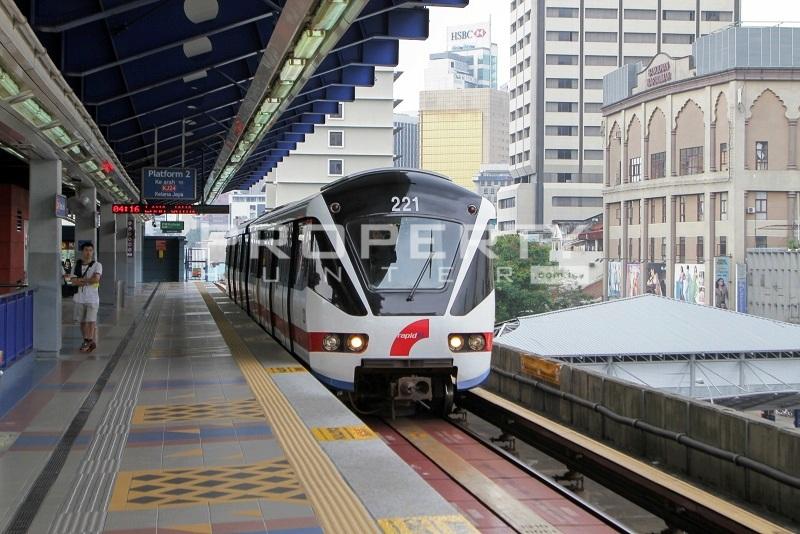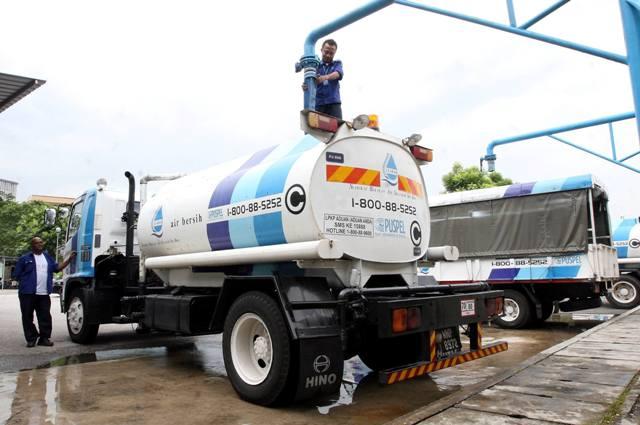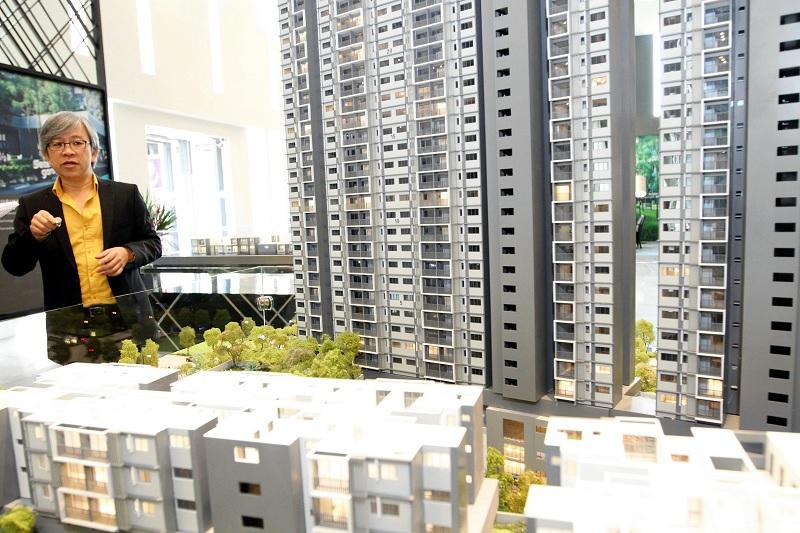With the construction of the 51km Sungai Buloh-Kajang Line (SBK) in full force, the market is already abuzz over the MRT's (Mass Rapid Transit) potential impact on property value According to MRT Corp (Mass Rapid Transit Corporation Sdn Bhd), the SBK line which starts from Sungai Buloh located to the north-west of Kuala Lumpur, runs through the city centre of Kuala Lumpur and ends in Kajang serving an estimated population of 1.2 million people. The 51km line will be underground for a distance of 9.5 km to be served by seven stations out of a total of 31 stations along the route.
THE Klang Valley MRT project involves the construction of a rail-based public transport network which, together with the existing light rail transit (LRT), monorail, KTM Komuter, KLIA Ekspres and KLIA Transit systems, form the backbone of the Greater Kuala Lumpur/Klang Valley region. Phase One of the MRT Sungai Buloh-Kajang Line from Sungai Buloh to Semantan is scheduled to be up and running by the end of 2016 while Phase Two from Semantan to Kajang will become operational by July 2017, allowing trains to serve the entire line. Each train serving the line will have four coaches having a total capacity of 1,200 passengers. It is expected to ferry approximately 400,000 passengers daily.
What will be the immediate and long-term effects of the new MRT lines on the property market in the Klang Valley? Most industry players are unanimous over one thing - properties within a reasonable distance from the new MRT stations will definitely see an increase in value. K.H. Sim, Chairman of Allstones Group Asia Sdn Bhd, a developer based in Kuala Lumpur, observes that the new MRT lines are already impacting the Klang Valley property market with land and properties in the vicinity of the line already commanding a higher price.
BULLISH SENTIMENT
"In the longer term, once the feeder bus services begin operations, properties in the surrounding vicinity will also experience a similar price increase. The MRT has become a strong selling point for existing and new developments along its route. I see the feeder bus services as a key component of the MRT as it connects passengers to the MRT for stations outside the central business district (CBD) of Kuala Lumpur" says Sim. Although there is general bullishness in the property market for areas within the vicinity of the MRT line, the Chairman of Allstones Group Asia feels that it might not be a general property "boom†as he believes that land and property prices have run ahead of the country's economic fundamentals, thus affecting the affordability factor.
"However, areas with newer or affordable housing will ultimately fare better than others. I see such opportunities in the southern sector of the MRT as properties in the northern sector of the MRT have run ahead of the secondary market with developers reporting sales of residential units above RM1,000 psf. There will be plenty of choices for both buyers and investors, and the general preference will be for new developments rather than older ones, but ultimately how many developments can be situated next to the MRT stations? Buyers should also consider the security, noise, privacy and maintenance issues for buildings within or adjacent to the MRT stations, given the premium they have to pay.â€
ADVANTAGES OF PROXIMITY
Sim notes that the main challenge for the property market and its players would be the intense competition for land along the MRT line. "We expect to see more players moving towards mid to high-end developments, banking on the advantages of close proximity to MRT lines and underscored by higher land costs and building materials. Land prices will be speculated as everybody is now trying to guess where the stations are for the MRT2 and MRT3 lines. Once the three lines are completed together and integrated with LRT, most of the Klang Valley will be connected and each location would no longer enjoy the distinct advantage of the MRT lines as before. It will be easier for office workers, local and foreign businessmen and others to travel for meetings, leisure, etc., instead of relying on cars or taxis. Thus, I would expect the government to impose some sort of road pricing or higher car park surcharges to encourage the usage of MRT in the CBD.â€
Sim also opines that decentralisation of the CBD is inevitable and is already taking place. "This is already happening and the trend will continue. The movement of activities mainly affects the commercial sector. With or without MRT lines, activities are already being moved further from the KL CBD, particularly for the business sector. Many offices are moving back-end operations further away from the city centre for the benefit of both their clientele and employees. KL CBD's concern will not be the decentralisation of business activities but rather the oversupply of office spaces. This will be more apparent with developments in the pipeline such as the Tun Razak Exchange (TRX) and the 118-storey Warisan Merdeka. There are certainly concerns but they could be overcome if the government continues to be proactive and places importance on security, corporate governance and transparency.â€
SELLING POINT
Renowned map maker Ho Chin Soon, whose famed buzzword "Follow the infrastructure†is repeated in his various property books and seminars, says that properties within walking distance of not more than 1,640 ft (500 metres) from the respective stations are expected to benefit. He explains that people might not be inclined to walk if the MRT station is further than that.
He continues to cite several ongoing developments such as the Tropicana Gardens in Kota Damansara by Dijaya Corporation Bhd that incorporates direct linkage to an elevated MRT station and Sunway Velocity, the integrated mixed project by Sunway Bhd near Jalan Cochrane as prime examples of property developers capitalising on the MRT factor as a key selling point.
The map maker feels that the property segments that stand to benefit most from the new MRT lines will be the residential sector in the outskirts of the Klang Valley and the commercial sector in downtown KL, especially in the CBD. "Workers will no longer need to drive to these locations. There will be higher demand from tenants to lease offices in these downtown locations. Most of the commercial components are downtown, whereas the residential components are at the fringes of the Klang Valley.
"It will also be interesting to see the developments at the Rubber Research Institute of Malaysia (RRIM) land in Sungai Buloh owned by the Employees Provident Fund (EPF) and how they are going to parcel it out and transform the area. I'm guessing there would be some commercial components and hopefully some affordable houses as well" says Ho referring to the 2,230 acres of prime land in RRIM, Sungai Buloh that was acquired from the government for RM2.28 billion by Kwasa Land Sdn Bhd, a wholly- owned subsidiary of EPF.
VITAL ACCESSIBILITY
Sr James KM Tan, Associate Director of Raine & Horne concurs with Ho that people are already buying properties along the SBK line and prices have gone up in these areas. He however acknowledged that in some areas where there are chronic congestion and physical disruption due to the construction process, some property values might even go down in the short term.
"Sure, people will buy a lot of properties in and around the areas of the MRT, but currently some of the properties along these tracks are quite badly affected by the construction. There might also be some property buyers who question the benefits of buying properties near the MRT. For example, why should I buy a house with its back facing the MRT with all the attendant noise? What happens if there's any train derailment or any other unexpected mishaps? There's always a likelihood of physical danger if the tracks, trains and facilities are not maintained properly many years down the line" says Tan.
Nevertheless, Tan feels that the MRT's long-term benefits should outweigh the possible negatives. "It is long overdue. Accessibility is vital. For example, if you are staying in Kajang, you can hop onto a train and reach Sunway Giza in minutes to do some shopping. Accessibility is also linked to profitability. It saves people's time and that means people are saving money. Businesses and commercial centres will also expand their catchment areas.â€
DOUBLE-EDGED SWORD
Integration is one of the critical factors to the long-term success of the MRT, and Tan cites examples of public transportation in Korea, Japan and Moscow as benchmarks of integrated Mass Rapid Transportation.
"Unfortunately, here the integration of the transport system is not up to mark. There are too many concessionaires to facilitate integration and it is very discouraging. Integration would make the life of the public easier and more efficient. It would improve accessibility and travelling time. Blue collared workers would have cost and time savings. They could also widen their availability in the employment market. Companies would find it easier to recruit staff who live far from the locations of their working places.
"In short, integration is one point that is always overlooked when planning for these transportation systems. For example, ample parking space is important at these MRT stations. Unless they have sufficient parking in and around these spots, it will create congestion and jam up the retail and commercial areas thus affecting the businesses at these stations" says Tan while warning that having a MRT station linkage will not be a 100 per cent guarantee of success for a property unless accompanied by proper management and planning for access roads and other contributing factors. He cites the example of Plaza Pantai in KL that has the Kerinchi LRT station integrated within its building but has still performed poorly over the years in terms of rental yields.
The Raine & Horne Associate Director also begs to differ from Sim's point of view and feels that the new MRT lines would not result in too much decentralisation of the CBD or lower property prices in the KL City Centre.
"Personally, I don't see it. Some of the bigger shopping centres in the suburbs will have their catchment areas increased but in others I don't think there will be any impact. People are creatures of habit. We won't go into an area unless we have a reason to. People will still go to town for shopping, sightseeing and other activities. For offices, there might be decentralisation but the multinational companies such as the oil & gas and financial companies would still want to be in the heart of town. So, the MRT wouldn't affect KL city's status as the CBD. If anything, it will probably improve it" argues Tan.
He also thinks that the MRT could be a double-edged sword in relation to the affordable housing issue, with savings from better connectivity perhaps being cancelled out by the projected increase in property prices in these MRT areas.
IMPORTANCE OF DEMOGRAPHICS
Dr Sr Rosli Said, Senior Lecturer in the Department of Estate Management, Faculty of Built Environment, University of Malaya points out that apart from connectivity and traffic, demographics also plays an important role in boosting the growth of the property market in these MRT related areas.
"If the MRT station is located along the high-end or "wealthier†areas, it won't drive the property market that much since most landlords in these locations tend to occupy the units themselves. This group of home owners would presumably prefer to drive their own cars. In addition, the age group of buyers also plays an important role in determining the growth of the property market in the affected areas. One may ask whether the MRT station is really convenient to everyone. We always see the term used "within a walking distance†from the station, but how do we define such term? For the younger generation, a 15-minute walk uphill to the station could still be considered convenient. On the other hand, purchasers aged 50 and above would not consider this as ‘within a walking distance'! He adds that by referring to the theories of urban growth, with the advent of the MRT, the activities in KL CBD will naturally spread to the fringes of KL.
"The theories state that the urban area will develop in sectors in which high, middle and low income residents will tend to group. High income groups will purchase the most desirable areas for their houses, middle income groups will strive to join the upper-income groups and the basic premise is that higher-income groups establish the general direction of urban growth. The growth pattern of Kuala Lumpur can be seen either heading to the South or West of the city. Depending on which income group we are referring to, it can either have a good or bad effect as far as the property market is concerned. The tendency of having new activities at the city fringe will actually create benefit to the middle income group due to lower transportation cost and rental rates, provided that their workplace is located within the new economic activities in this area" says Rosli.
He also suggests that when dealing with housing affordability in relation to MRT stations, we need to consider both housing and transportation costs. "Housing cost includes monthly mortgage payments, property taxes, insurance, utilities as well as property management and maintenance fees. The housing cost is the single biggest expense for most households. Transportation cost includes commuting costs (for transit riders) and petrol, insurance, car payments, insurance and maintenance (for car owners). Transportation costs are the second biggest expense on the household's income. Both costs are very important especially for middle income groups because the combination of these costs claims about half of the average household's budget.
"As such, the type of dwelling purchased and the type of transportation options would dramatically affect affordability. MRT lines could affect this particular group because its development will actually lead to increases in property values and in turn, threaten affordability. There is no way that affordable homes could be developed along the MRT routes unless the land bank is acquired near proposed MRT stations before the government announces the proposed MRT development or before speculators drive up prices.â€
Finally, the UM lecturer cautions that affordability issues could get even worse unless the government intervenes with provisions of specific areas designated for affordable homes along these MRT lines or through mechanisms such as covenants and shared-equity arrangements.
.jpeg)

_PH_Banner_(Desktop)(1200x180px).png)





.jpeg)
